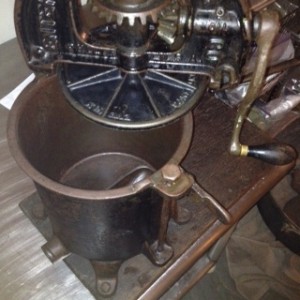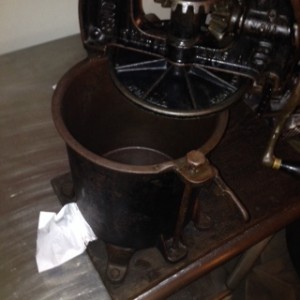Mainstream, boneless, enhanced pork loins (pumped 10 – 12 %) often sell for about a dollar less per pound than enhanced baby back ribs; probably because how difficult it is for the average consumer to keep ultra lean pork loins from drying out when cooked. If you care to see short blog post discussing modern mainstream pro chops click here. This chronically low price on lean and tender, mostly one muscle, pork loins speaks volumes about a lack of demand for them. Conversely, the intercostal muscles of rib containing cuts do a much better job of retaining moisture when cooked, and also have some desirable collagen flavor. Shrewd meat cutters often leave about 1/4 inch of loin meat on back ribs in order to sell more of the higher demand-priced cut. That practice sits well with consumers because they are happy to be buying meatier ribs. However, by the time collagen containing rib meat gels tender, via low temperature moist heat cookery, naturally tender & lean loin meat attached to the ribs will become dry. Dried out smoke-cooked meat is the reason BBQ sauce was invented.
Last week a local supermarket chain offered 12% pumped boneless pork loins at $1.79 per pound. Admittedly, that’s not news since for many years mainstream, enhanced, boneless pork loin prices have often been around $2 per pound. In light of that fact I have long been looking for practical ways to use enhanced boneless pork loins in further processed products. Unfortunately, pork loin attributes do not lend themselves well to smoke-cooked pulled-pork or shredded Goetta production. Anyway, the more flavorful pork shoulder has great natural attributes for pulling/shredding, plus both butts and picnics are a little lower priced than loins. With those thoughts in mind I decided that during further processing enhanced boneless pork loins should be ground and not over cooked.
As luck would have it last week, my wife requested another batch of Goetta. Our oldest daughter, a Registered Dietitian, will be visiting soon and she loves lean Goetta due to its good taste and health benefits. A lot of the perceived health benefits of Goetta come from its high percentage of hydrated steel-cut oats. As a meat processor I especially like oats because like soy-grits they soak up about 3 times their weight of water and retain most of it even when making pre-cooked meat products. Also like soy -grits, oats make a good fat substitute or mimic to help improve finished meat product palatability. However, soy requires a high amount of processing to get the beany flavor out of grits; while oats are naturally mild flavored. Commercially, grain product containing meat items have to have enough caramel coloring added to them so end-products will display an expected cooked meat color. To date Goetta has not become a mainstream product anywhere, not even in Cincinnati. Goetta’s desirable attributes are mainly disregarded because of its bland appearance and the perception that it’s full of scraps, as scrapple is. And. commercially Goetta does have beef hearts, pork skins and a good bit of fat, as well as MSG in it. The old-school shredded meat Goetta, that I was taught to make by my parents, is nothing but good and good for you. If you would like to see that process click here.
This R&D project is about marrying pork breakfast sausage with Goetta in order to develop a hybrid off-spring that displays more desired attributes than either of the parent products.
-Finished batch size is 25 pounds.
-Fine dice 4 large onions then boil them in about 5 cups of water for 20 to 25 minutes; until onions become tender.
-Place 4 cups of steel-cut oats in a medium size cover-able oven roasting pan then add 12 cups of onion-water. Add tap water, if needed, to reach 12 cups. Also stir in the following: 5 1/3 Tbsp. purified salt, 1 3/4 Tbsp. fine ground white pepper, 4 Tbsp. rubbed sage, 2 tsp. ginger, 1 1/2 Tbsp. nutmeg, 2 Tbsp. thyme, 1 tsp. ground cayenne pepper and 1 3/4 Tbsp. brown sugar. Seasoning blend should be adjusted to personal taste by cooking a patty prior to stuffing entire batch into plastic chubs.
-Cook oat-onion-seasoning mix at 250F in a covered roaster until oats are soft. It will take about 1 1/2 hours, stir 2 or 3 times during cooking.
-Cool mix then chill overnight in refrigeration.
-18 pounds of enhanced boneless pork loins. They were meat plant pumped 12% with a water, salt and sodium phosphate containing solution.
-Cut pork loins into pieces that will easily pass through your grinder.
-Combine pork with oat mix then grind once through a 3/16 inch hole size plate. Push the last of the batch out of the grinder’s head by running 2 slices of frozen bread. Next time I may try a 3/8 inch plate to see if I like finished product texture better that way.
-Was able to use the stuffing tube attachment part of this stuffer for filling 1 1/2 pound plastic chubs.
-Chubs were sealed with hog-ring clips.
-Chubs spread out for quick freezing.
-Partially frozen, thin sliced patties.
-Cooked patties were very good tasting. Texture was a little soft. Cooked to 150F internal so ground pork loin was not overcooked.
This is a healthy, delicious product that is simple to make. Further, there is no meat or onion cooking loss, added water substantially reduces production costs and since it’s not sold pre-cooked there isn’t any cooking loss incurred there either.










